U.S. oil producers will have cut production by 1.7 million barrels per day by the end of June as a result of the demand destruction from the coronavirus pandemic and the oil price war between Saudi Arabia and Russia. While China is filling its storage facilities under ultra-low prices, U.S. oil producers have almost filled available storage to capacity. The Department of Energy even leased space in the nation’s Strategic Petroleum Reserve (SPR) to provide additional storage to producers. Further, some companies are using pipelines as an innovative way to store more oil.
The coronavirus pandemic caused global liquids demand to drop by about 30 percent, which sent oil prices plunging. The Organization of the Petroleum Exporting Countries and allies led by Russia (OPEC+) struck a deal last month to cut output by 9.7 million barrels per day for May and June, but continued to produce at higher levels for April, with Saudi Arabia selling at discounted prices. This resulted in even lower prices.
The drop in oil prices caused North American producers to cut production. The United States and Canada, which produce over 17 million barrels per day, are cutting output by about 10 percent. Numerous producers in North America announced sizeable cuts, including ConocoPhillips, Exxon Mobil, Chevron Corp and Canada’s Cenovus Energy. ConocoPhillips said that it will reduce 460,000 barrels per day across the United States and Canada. Exxon Mobil announced worldwide cuts of roughly 400,000 barrels per day, with two-thirds of that from the two countries.
Normally, with price drops, demand rebounds. But, with lockdowns from the coronavirus pandemic, Americans are no longer travelling for work or for fun or family. So, the rebound will need to wait until the lockdowns are removed, which is just beginning state by state.
Demand Destruction
U.S. consumption of petroleum products fell to its lowest level in decades because of lockdown measures from the coronavirus pandemic. The Energy Information Administration (EIA) estimates consumption by examining the changes in total product supplied. Total petroleum demand averaged 15.35 million barrels per day in the week ending May 1—28 percent lower than the March 13 value—about when the lockdowns began. In the week ending May 1, total U.S. product supplied of petroleum products fell by 0.4 million barrels per day from the previous week. The lowest level occurred the week ending April 10 at 13.8 million barrels per day.
Over that same period (week ending March 13 vs. week ending May 1), motor gasoline demand fell by 31 percent, distillate demand fell 22 percent and jet fuel demand fell by 70 percent.
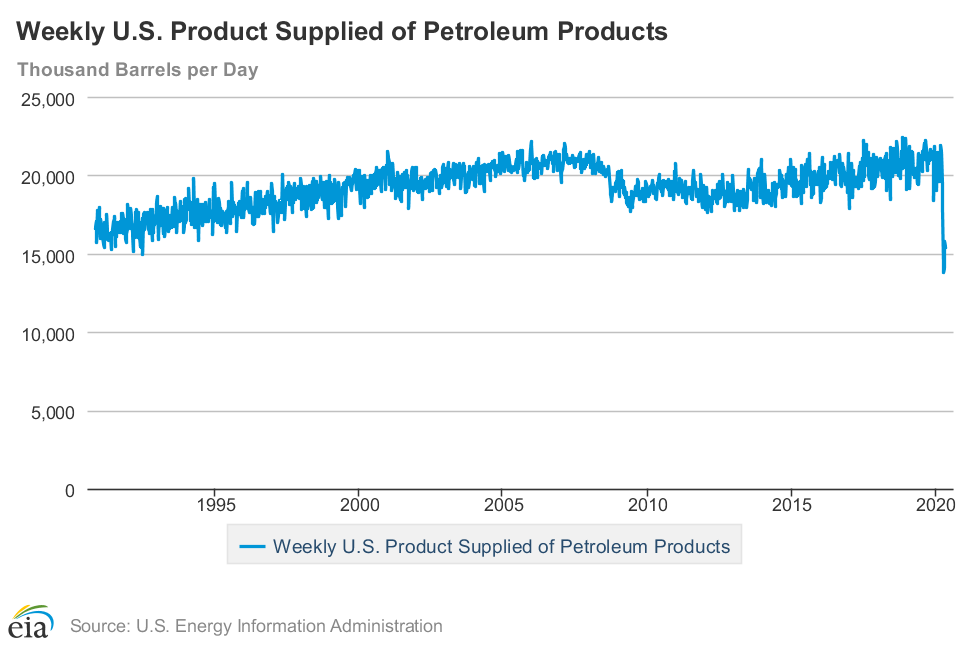
U.S. Oil and Petroleum Stocks
Oil inventories fall into two categories—commercial stockpiles and strategic reserves held for emergencies. As of the end of April, the Energy Information Administration (EIA) reported U.S. commercial crude oil inventories (excluding those in the Strategic Petroleum Reserve (SPR)) at 532.2 million barrels–about 12 percent above the five year average for this time of year. At that level, inventories may soon pass the record set in March 2017 of 535.5 million barrels. At the same time, EIA reported an increase of 1.7 million barrels in the SPR reaching 637.8 million barrels.
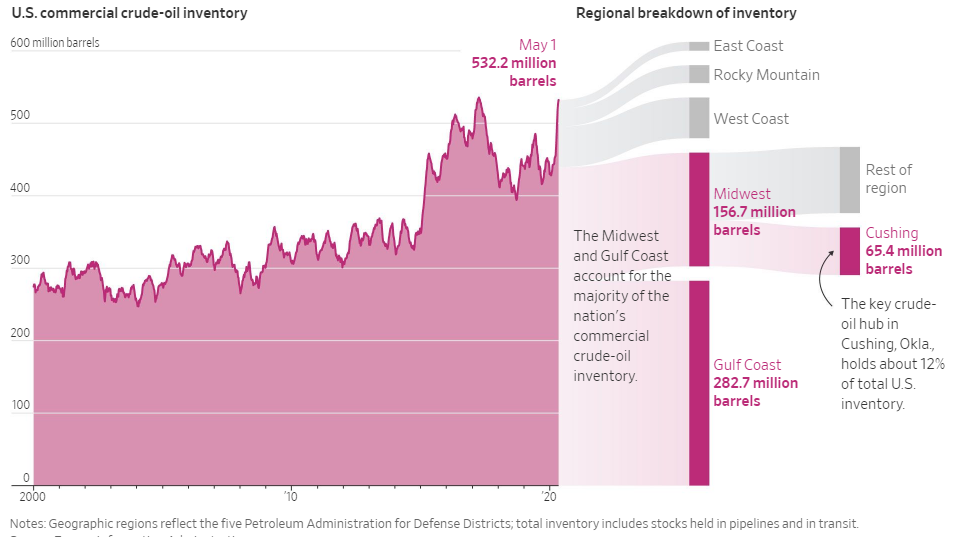
The increase in commercial oil stocks has been pronounced in Cushing, Oklahoma—a key hub for oil stocks. Because of logistical hurdles, storage tanks cannot be filled to the brim. Thus, it is difficult to know how much space is actually available. The official EIA data show Cushing inventories are rising at a pace that would have them completely full in weeks.
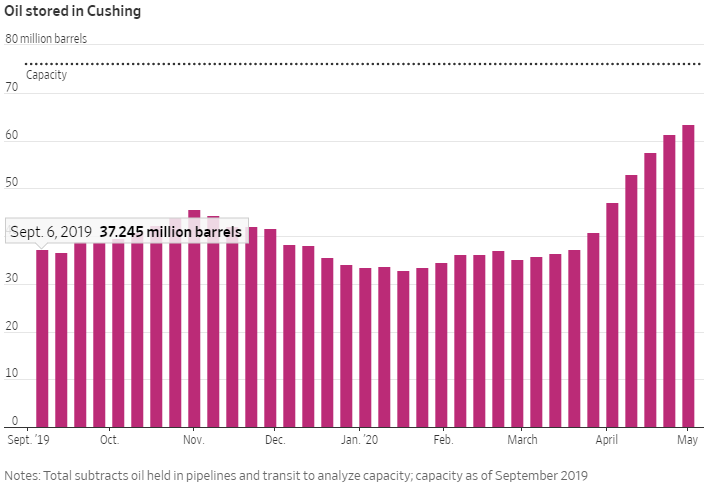
In addition to Cushing, other U.S. storage hubs are located in the Gulf Coast. But, oil at discounted rates from Saudi Arabia is arriving in the region, making the glut even worse. The excess oil is forcing energy companies to curb spending and shut in productive wells with some companies starting to file for bankruptcy and lay off employees.
There is also a large amount of oil in the U.S. Gulf of Mexico and off the California coast in floating storage facilities.
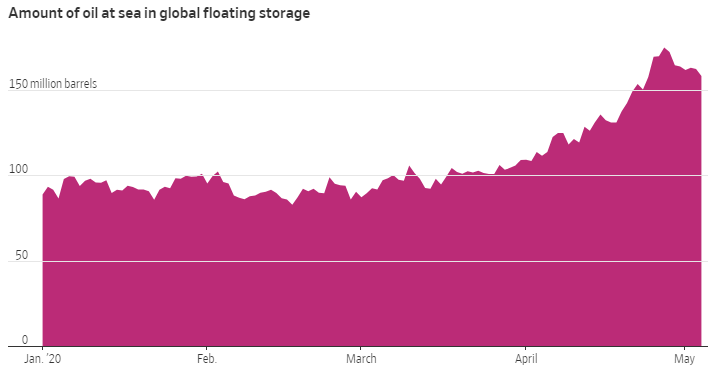
U.S. motor gasoline inventories were about 9 percent above the five year average for the week ending May 1, and distillate fuel inventories were about 12 percent above the five year average.
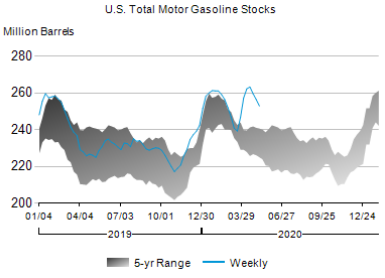
Oil and Gas Rigs
The number of operating oil and natural gas rigs fell to an all-time low—reflecting data going back 80 years. U.S. operators have idled more than half of the 796 drilling rigs that were in operation at the start of the year due to the collapse in oil prices, leaving thousands of oil workers unemployed. The rig count fell to a record low of 374; the prior all-time low was 404 rigs in May 2016. U.S. drillers have cut an average of 52 rigs per week since mid-March after crude prices started to fall due to the lockdowns from the coronavirus pandemic and the oil price war between Saudi Arabia and Russia.
The rig count in Canada fell to a record low of 26 rigs several weeks ago.
Conclusion
The state lockdowns from the coronavirus pandemic and the oil price war between Saudi Arabia and Russia have brought havoc upon the U.S. oil industry—not seen in its history. As a result, there is a glut of oil on the market with storage near capacity and oil prices have plummeted. Oil producers have had to cut production, idle wells, and lay off workers. Once the lockdowns are removed, the industry can start to recover, but it will not be a very quick recovery as not only will demand have to be restored, but the storage glut will need to be severely reduced.



